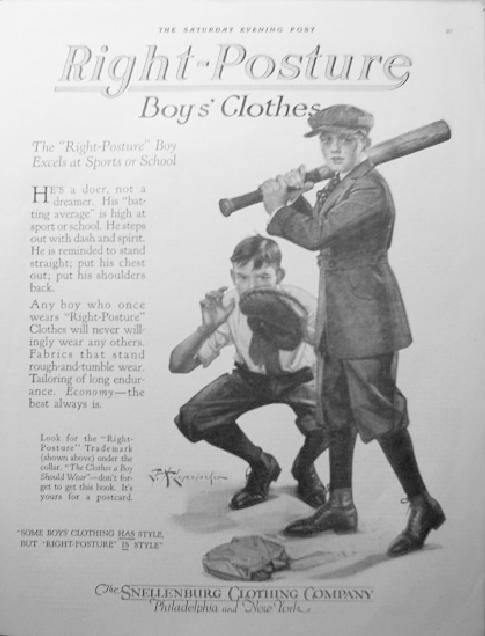
Figure 1.-- This Right-Posture ad appeared in the "Saturday Evening Post" (April 17, 1920). The illustrator was F.X. Leyendecker. The batter weara a stylish Norfolk knickers suit. |

|
We notice a Right-Posture Nofolk suit in a Saturday Evening Post advertisement. The Right-Posture suit illustrated here is a two-piece suit, a Norfolk jacket and knickers. Right-Posture was a brand name for the Snellenburg Clothing Co. Norfolk styling was a major style in the 1910s and still stylish in the early 20s. No specific details are provied on the suit because the ad here was to advertize the brand and not a particular garment. The illustrator was F.X. Leyendecker, anoted illustrator from the early 20th century.
Right-Posture was a brand of boys clothing for the Snellenburg Clothing Co., a Wisconsin manufacturer. We note in the 1920s that Right-Posture offed a full range of clothing, including boys' and girls' clothes. We do not know a lot about the company yet. They apparetly advertised in major magazines. The destinctive illustrations were done by JC Leyendecker who also did illustrations for Kuppenheimer, Arrow Shirts, and other manufacturers.
No publication is so closely linked with the traditions of 20th century America as the The Saturday Evening Post. Cyrus Curtis founded The Ladies Home Journal (1883). With the succes of the Journal he founded the Curtis Publishing Company (1890). A few years later he happened upon a sixteen-page, un-illustrated weekly with a readership of less than 2,000 and virtually no paid advertising 1897). The paper's lineage indicated it was descended from Ben Franklin's Pennsylvania Gazette. Curtis turned it into one of the most important periodical magazines in America. It was the most popular American magazine in the first half of the 20th century. The Post included political cartoons, artwork, literary works, and much more. The Post was especially known for its covers which were done by important illustrators like Norman Rockwell. The work of popular authors appeared in The Post. It was in The Post that Lassie first appeared. Although mundane at the time, even the advertisements make issues of the Post fascinating to modern readers. The Post came to compete wuth Look and Life. The Post was a bit different than these two magazines. It did not have the focus on current news and photography like the other two publications had.
The destinctive illustrations were done by Frank Xavier Leyendecker. He was the younger brother of J.C. Leyendecker. They were two of the most prolific and well know illustrators of the 20th century.
They worked just as lithograpic technology made possible georgious color illustrations. Joseph was born in Germany (1874) and Frank (1876). His parents brought Joseph and Frank to America as young boys (1882). From an early age they both domstrated a prodigious talent. Their parents did their best to encourag his talent, but as immigrants, there financial circumstances were limited. Frank is generally considered the "lesser" Leyendecker. Joseph had a longer and more notable career. This should not take away from the prodigeous talents of Frank. Many art historians believe that it was Frank that created the style in which both drew. Frank did colorful and creative illustrations for posters, cover art, book plates, advertising, and much more. He did covers for mahor magazines like Vanity Fair, Life, and Vogue. He also did advertisements for important companies like Durham Hosiery, Remington Guns, Palmolive, Howard Watches, and Willy's Motors. His brother specialized more in clothing.
Note that the batter here is pictured wearing a suit abd the catcher a shirt and tie. This seems a bit formal for a game of baseball, but boys did dress more formally in the 1920s. Thus the illustrator could place his subjects in a sports setting, even though he was illustrting a suit.
Interested clients could send in a postcard and get a booklet prepared by the company, "The Clothes a Boy Should War". Unfortunaely we do not have a copy. We would love to see one as it would undoubtedly have some very useful information aboutperiod clothing and fashion.
The Right-Posture suit illustrated here is a two-piece suit, a Norfolk jacket and knickers. Norfolk styling was a major style in the 1910s and still stylish in the early 20s. No specific details are provied on the suit because the ad here was to advertize the brand and not a particular garment.
The boy wears several items oher than the Norfolk suit. First he wears a flat cap which was very popular with boys at the time. We have seen these caps done in the same material and color as the suits, but in this case it was a slightly different color. Both boys wear wear black long stockings. Black was still very popular wat the time and worn with suits of various colors. Both boys wear high-top shoes, both brown and black. Low top shoes were available abd gradually becomng popular, but high-top shoes were still very common for school-age boys.
Other Boys' Historical Clothing Web Site Related Pages:
[Long hair]
[Ringlet curls]
[Hair bows]
[Bangs]
[Sailor Hats]
[Blouses]
[Collars]
[Bows]
<Sailor suits]
[Kilts]
[Smocks]
[Pinafores]
[Long stockings]
[Stocking supporters]
Navigate the Boys' Historical Clothing Web Site:
[Return to the Main U.S. 1920 catalog page]
[Return to the Main U.S. 1920s catalog page]
[Introduction]
[Activities]
[Biographies]
[Chronology]
[Cloth and textiles]
[Clothing styles]
[Countries]
[Topics]
[Bibliographies]
[Contributions]
[FAQs]
[Glossaries]
[Images]
[Registration]
[Tools]
[Boys' Clothing Home]
